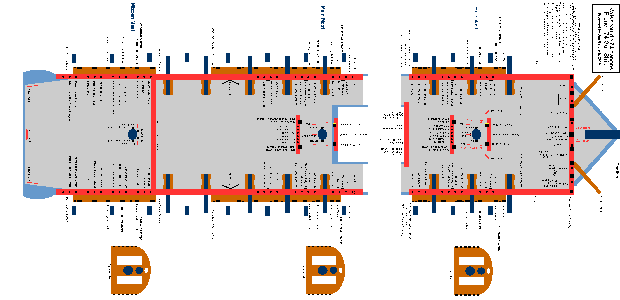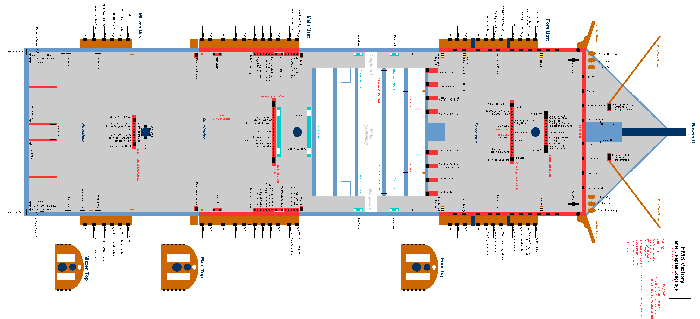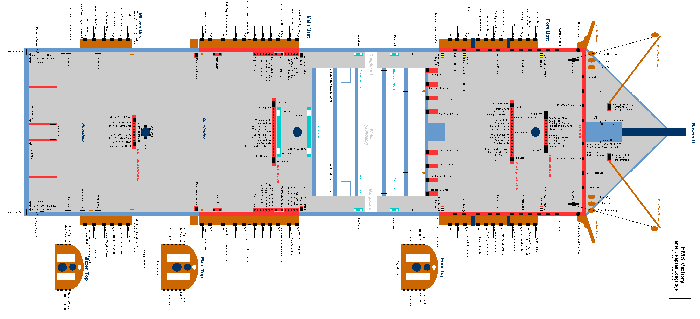
U.S. ship of the Line Pennsylvania, 140 guns [Source: Wikipedia]
|
|
The "Ship of The Line" earned its name from a naval war tactic: to sail a number of ships in a row, each bow to stern, forming a "line of battle" at sea.
And this was a logical consequence of the construction of the ships: almost all cannons were mounted on the sides of the ship, on one, two, three
or even four gun decks, the larger, the more guns
it could carry and use against an enemy. This tactic was "established" around 1650 among all sea powers, and kept as a standard over 250 years.
The first ships of the line were rather small and had between 30-50 guns. Over the ages, they were built ever larger, until in 1900, the biggest ships
of the line carried up to 150 guns, on a ship twice as large or more than the first ships.
Especially England (later Great Britain), France and Spain established a Rating System to classify their ships of the line. These systems varied from country to country
and were modified over the ages, but essentially they classified the ships on their size, number of decks and number of cannons.
Some rates became more famous than others, especially the "74", invented by the French in 1750 and copied by the British. It is reported that after 1750,
the 74s became the work horses of all navies, over the half of all ship types were 74s in 1800 when Lord Nelson fought his famous battle against the allied
French and Spaniards.
Of course, these ratings was a classification
on paper only. In reality, ships of the line had the full range between 50 to 150 cannons, "just as needed" as we would say today.
The number was so large because these cannons could not aim accurately, as they shot cannon balls, and no modern aerodynamincly shaped projectiles.
After all, the ship of the line was nothing but a naval platform for a number fo guns, driven by sails.
As the developement of these ships was rather slow and gradually, so was also the developement of their rigging. It was derived from the
galleons and extended more and more.
The large Elisabethan galleon already had 3 yards on its two square rigged masts. Now, the "second mizzen mast", sometimes called "Bonaventure mast",
disappeared and the masts became higher and the yards wider, even the topsails and topgallants. And on top of the last, a forth yard, the "royal sail"
could be set, but those were used in calm weather only. The larger the ship, the larger was its rigging, but essentially, even through the ratings,
the same rigging was shared among all ships of the line, in every seafaring nation of that era:
-
Bowsprit: 2-4 fore triangular staysails [staysail, jib, outer jib, flying jib], sprit yards without sails
-
Fore Mast: 3-4 square sails [course, topsail, topgallant sail, royal sail], auxiliary stunsails on each side of each yard
-
2-4 main quadrangular staysails, rarely used
-
Main Mast: 3-4 square sails [course, topsail, topgallant sail, royal sail], auxiliary stunsails on each side of each yard
-
1-3 mizzen quadrangular staysails, rarely used
-
Mizzen Mast: lateen mizzen, or later, the quadrangular "spanker" mizzen, and 2-3 square sails [topsail, topgallant sail, royal sail],
very rarely auxiliary stunsails on each side of each yard (douptful)
- NOTE: royal sails, the forth, uppest yards on the masts, were standard on bigger or later ships of the line. The first or smaller fighting ships could also set them,
but those were used very rarely, "flying" with a minimal running rigging, just a halyard and sheets. Even the Victory that is depicted so
often with 3 square sails only on each mast, could set royals in light winds. They were as auxiliary as the stunsails.
Foremost, the mizzen mast was made ever bigger dramatically. At the beginning it was just as small as the bowsprit, carrying one lateen mizzen sail only.
Then it was extended with a topmast that carried a square mizzen topsail. Later, the mizzen topgallant and even mizzen royal was added on top of it.
Around 1750, new types of auxiliary sails appeared:
staysails, to stabilize the course of the ship in the wind, also in a storm, and to catch the wind from abeam.
stunsails, to be used in calm weather only, to maximize the sail area in order to catch as much wind as possible.
On the other hand, the square spritsails disappeared with all its running gears,
and instead, a "naked" yard that was never moved anymore, but gave the bowsprit more side stability,
became part of the standing rigging.
This rigging, on 3 masts, was the standard rigging of a "ship", not only of the ships of the line (shared among all rates), but also to
other types like the East India Men and other merchant sailing ships. And, the rigging of the ships of the line was the origin
from which the rigging of the clipper ships and the windjammers was developed later on.
|
Sources and Books
There are plenty of books and information available about the ships of the line. This is due to the fact that the construction of these ships
conincided with the era of science, after 1600, where for the first time, plans and models were used to design and build the real ships.
Especially the British preserved a large number of documents in their maritime archives,
and most of the literature about his topic is available in English, too.
Belaying Schemes (Reconstruction)
Although we do have a lot of deck plans, alass, no original belaying scheme has prevailed, if it ever existed (for the most seamen could not read
and knew their profession by heart).
Due to the long time ships of the line were used in all sea power countries, there are many varieties according to the era, size, rate and rigging of the ships.
A French 74-gun ship of 1750

This is my personal reconstruction. I used the third volume of Boudriots "Le vaisseau de 74 canons", but was not content with his version - too many
"errors", asymmetries and missing lines. I will apply my own plan on my models ...
For all who want to check the plan that Boudriot had in mind, here is it (as mapped to a non-geometric plan scheme), in French and English:

When You look closely You will find some strange things, that is why I made my own version...
UPDATE 2010-12-11:
after requests of the German modellers forum Wettringer Modellbauforum, here is my bilingual version English/German
auf Wunsch des Wettringer Modellbauforums, hier eine zweisprachige Version meiner Überlegungen:

The HMS Victory, a 100-gun ship, around 1800
There is a belaying plan published by C Napean Longridge in his Bible of the Victory, "The Anatomy of Nelson´ Ships".
The problem with this plan is, that is was drawn long after the last time when the HMS Victory put to sea and used her sails.
The rigging already was a symbolic museum ship rigging, missing most of its running rigging, and so forth.
Longridge´s plan is still of high value, yet, I am about to revise it for my model...

And here is my personal, revised version:

NOTE: the Victory, the most famous sailing ship of the line in the world, was built in 1765, but rebuilt many times.
It is very likely that also the belaying scheme had altered many times during her life.
What we have today is a "snapshot of history",
with many questions that will remain unanswered for us. Yet, it is possible to reconstruct a model of the Victory,
that carries a functional rigging. The real Victory will put to sea never again, and the last time she wore sails is more than 150 years ago.
The Victory of today, in her last dock in Portsmouth, has a reduced museum rigg only.
|




